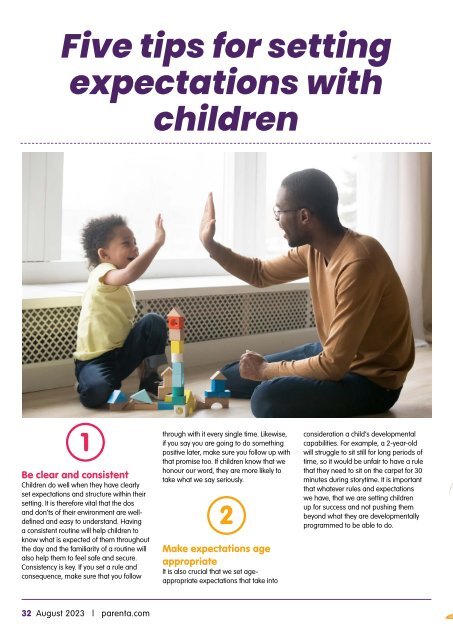August 2023 Parenta magazine
- No tags were found...
Create successful ePaper yourself
Turn your PDF publications into a flip-book with our unique Google optimized e-Paper software.
Five tips for setting<br />
expectations with<br />
children<br />
1<br />
Be clear and consistent<br />
Children do well when they have clearly<br />
set expectations and structure within their<br />
setting. It is therefore vital that the dos<br />
and don’ts of their environment are welldefined<br />
and easy to understand. Having<br />
a consistent routine will help children to<br />
know what is expected of them throughout<br />
the day and the familiarity of a routine will<br />
also help them to feel safe and secure.<br />
Consistency is key. If you set a rule and<br />
consequence, make sure that you follow<br />
through with it every single time. Likewise,<br />
if you say you are going to do something<br />
positive later, make sure you follow up with<br />
that promise too. If children know that we<br />
honour our word, they are more likely to<br />
take what we say seriously.<br />
2<br />
Make expectations age<br />
appropriate<br />
It is also crucial that we set ageappropriate<br />
expectations that take into<br />
consideration a child’s developmental<br />
capabilities. For example, a 2-year-old<br />
will struggle to sit still for long periods of<br />
time, so it would be unfair to have a rule<br />
that they need to sit on the carpet for 30<br />
minutes during storytime. It is important<br />
that whatever rules and expectations<br />
we have, that we are setting children<br />
up for success and not pushing them<br />
beyond what they are developmentally<br />
programmed to be able to do.<br />
3<br />
Remember children are<br />
little people<br />
It is important to remember that children<br />
are little people with their own minds.<br />
Sometimes our expectations can be quite<br />
high and if the shoe was on the other foot,<br />
we’d struggle ourselves. For example, how<br />
would we feel if we were engrossed in a<br />
project and someone came along, took it<br />
from us without warning and demanded<br />
that we went to lunch? We’d be furious<br />
and totally frustrated! The same applies<br />
to children. Quite often we will move them<br />
from task to task with no warning and then<br />
wonder why they are having a meltdown.<br />
It’s important to treat children as we would<br />
like to be treated. A simple fix to that<br />
scenario would be tell them that lunch will<br />
be in 10 minutes and to allow them time to<br />
wrap up what they are doing. I always put<br />
myself in my children’s shoes and ask how<br />
I would react in the same situation. If they<br />
answer is ‘badly’, I amend my approach.<br />
4<br />
Give it time<br />
Routines and boundaries take time to<br />
embed. Sometimes you have to work at it<br />
for a while and give children time to adjust.<br />
Again, consistency and repetition are key.<br />
Children may need a few reminders and<br />
some redirection, but in time they will get<br />
there. Just gently guide them in the right<br />
direction, follow through with everything<br />
you say, have strong boundaries and the<br />
rest will eventually fall into place.<br />
5<br />
Lead with love<br />
We don’t need to be critical with our<br />
approach. No person is going to be their<br />
best self if they feel like they are failing. It<br />
is therefore important that we implement<br />
rules and expectations from a place of<br />
love. Children will naturally fight against<br />
change. However, ultimately, boundaries<br />
and structure make them feel safer. If<br />
we can assert ourselves but maintain<br />
the message that we care deeply whilst<br />
doing this, children will be more likely to<br />
cooperate. It may take time to stick, but it is<br />
important that we nurture our child-adult<br />
bond in the process.<br />
Stacey Kelly<br />
Stacey Kelly is a former French and<br />
Spanish teacher, a parent to 2 beautiful<br />
babies and the founder of Early Years<br />
Story Box. After becoming a mum, Stacey<br />
left her teaching career and started<br />
writing and illustrating storybooks to help<br />
support her children through different<br />
transitional stages like leaving nursery<br />
and starting school. Seeing the positive<br />
impact of her books on her children’s<br />
emotional well-being led to Early Years<br />
Story Box being born. Stacey has now<br />
created 35 storybooks, all inspired by her<br />
own children, to help teach different life<br />
lessons and to prepare children for their<br />
next steps. She has an exclusive collection<br />
for childcare settings that are gifted on<br />
special occasions like first/last days,<br />
birthdays, Christmas and/or Easter and<br />
has recently launched a new collection<br />
for parents too. Her mission is to support<br />
as many children as she can through<br />
storytime and to give childcare settings an<br />
affordable and special gifting solution that<br />
truly makes a difference.<br />
Email: stacey@earlyyearsstorybox.com or<br />
Telephone: 07765785595<br />
Website: www.earlyyearsstorybox.com<br />
Facebook: https://www.facebook.com/<br />
earlyyearsstorybox<br />
Twitter: https://www.twitter.com/<br />
eystorybox<br />
Instagram: https://www.instagram.com/<br />
earlyyearsstorybox<br />
LinkedIn: https://www.linkedin.com/in/<br />
stacey-kelly-a84534b2/<br />
32 <strong>August</strong> <strong>2023</strong> | parenta.com<br />
parenta.com | <strong>August</strong> <strong>2023</strong> 33
















